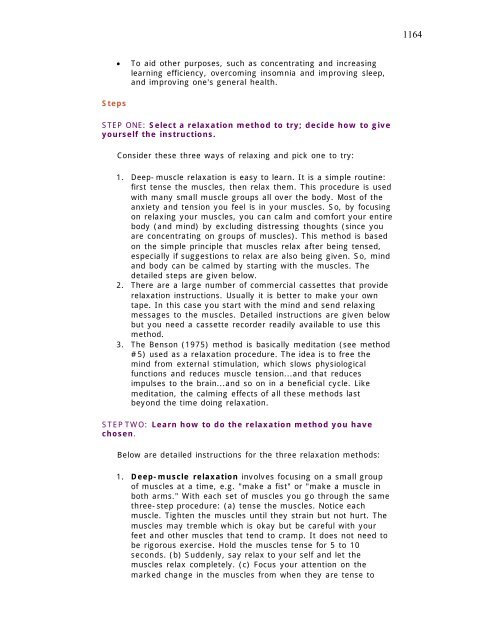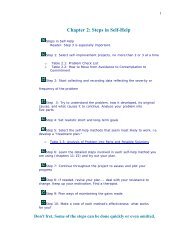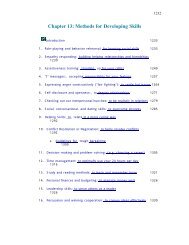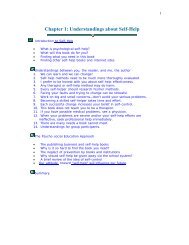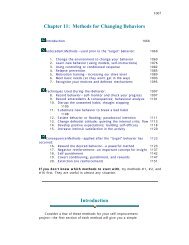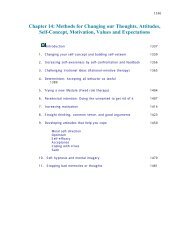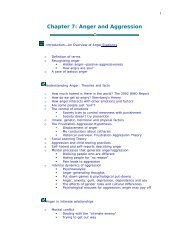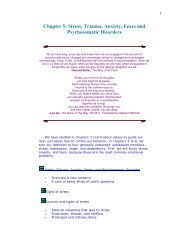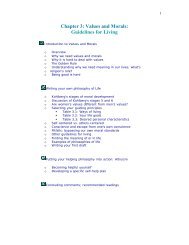Chapter 12: Methods for Changing Emotions - Psychological Self-Help
Chapter 12: Methods for Changing Emotions - Psychological Self-Help
Chapter 12: Methods for Changing Emotions - Psychological Self-Help
You also want an ePaper? Increase the reach of your titles
YUMPU automatically turns print PDFs into web optimized ePapers that Google loves.
1164<br />
Steps<br />
· To aid other purposes, such as concentrating and increasing<br />
learning efficiency, overcoming insomnia and improving sleep,<br />
and improving one's general health.<br />
STEP ONE: Select a relaxation method to try; decide how to give<br />
yourself the instructions.<br />
Consider these three ways of relaxing and pick one to try:<br />
1. Deep- muscle relaxation is easy to learn. It is a simple routine:<br />
first tense the muscles, then relax them. This procedure is used<br />
with many small muscle groups all over the body. Most of the<br />
anxiety and tension you feel is in your muscles. So, by focusing<br />
on relaxing your muscles, you can calm and com<strong>for</strong>t your entire<br />
body (and mind) by excluding distressing thoughts (since you<br />
are concentrating on groups of muscles). This method is based<br />
on the simple principle that muscles relax after being tensed,<br />
especially if suggestions to relax are also being given. So, mind<br />
and body can be calmed by starting with the muscles. The<br />
detailed steps are given below.<br />
2. There are a large number of commercial cassettes that provide<br />
relaxation instructions. Usually it is better to make your own<br />
tape. In this case you start with the mind and send relaxing<br />
messages to the muscles. Detailed instructions are given below<br />
but you need a cassette recorder readily available to use this<br />
method.<br />
3. The Benson (1975) method is basically meditation (see method<br />
#5) used as a relaxation procedure. The idea is to free the<br />
mind from external stimulation, which slows physiological<br />
functions and reduces muscle tension...and that reduces<br />
impulses to the brain...and so on in a beneficial cycle. Like<br />
meditation, the calming effects of all these methods last<br />
beyond the time doing relaxation.<br />
STEP TWO: Learn how to do the relaxation method you have<br />
chosen.<br />
Below are detailed instructions <strong>for</strong> the three relaxation methods:<br />
1. Deep-muscle relaxation involves focusing on a small group<br />
of muscles at a time, e.g. "make a fist" or "make a muscle in<br />
both arms." With each set of muscles you go through the same<br />
three-step procedure: (a) tense the muscles. Notice each<br />
muscle. Tighten the muscles until they strain but not hurt. The<br />
muscles may tremble which is okay but be careful with your<br />
feet and other muscles that tend to cramp. It does not need to<br />
be rigorous exercise. Hold the muscles tense <strong>for</strong> 5 to 10<br />
seconds. (b) Suddenly, say relax to your self and let the<br />
muscles relax completely. (c) Focus your attention on the<br />
marked change in the muscles from when they are tense to


